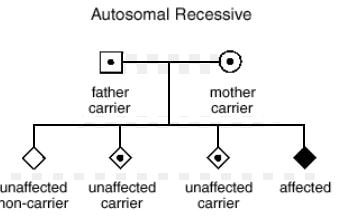Usher Syndrome
What is Usher Syndrome?
Usher Syndrome is a combination of hearing and vision complications with multiple symptomatic features are prominent to the affected person. [1,2]
Symptoms of Usher Syndrome
Retinitis pigmentosa is the classic feature of Usher Syndrome. The retinitis pigmentosa arises due to progressive degeneration of the retina and causes night-blindness and a loss side vision (peripheral vision). The vision of the eye depends upon the retina. “Tunnel vision” or the narrowing of the vision is the resultant of retinitis pigmentosa and affected person only capable to see straight ahead vision.

Other than hearing body balancing is another important function of the ears. Severe body balancing difficulties also very common with Usher syndrome due to ear problems. [2,3]
Types of Usher Syndrome
There are four types of Usher syndrome and can be described as:


Usher syndrome type I
The characteristic features of a Type I Usher syndrome are as follows:
- Congenital deafness (complete hearing loss at birth)
- Balance problems
- Delayed walking (affected children may not walk till 18 months of age)
- Vision problems started after 10 years of age and gradual deterioration causes onset of night blindness at approximately age of 20 years.
- Affected child often experienced the progressive loss of peripheral vision in Type I Usher syndrome.
Usher syndrome type II
The characteristic features of the Type II Usher syndrome are as follows:
- Complete or partial congenital deafness
- The gradual degeneration is not associated with partial hearing loss
- Retinitis pigmentosa is developed after puberty or in early adulthood
- The onset of night blindness is progressing at the late twenties or thirties.
- The progression of associated visual impairments due to Usher syndrome Type II is delayed than those affected with Type I.
Usher syndrome Type III
The characteristic features of Type III Usher syndrome are as follows:
- No congenital hearing or balancing problems.
- Onset of hearing problem and gradual deteriorating condition arises at the age of adolescence.
- Retinitis pigmentosa has also started after puberty and outcome are progressive vision loss.
Usher syndrome Type IV
The characteristic features of the Type IV Usher syndrome are as follows:
- Rare types of Usher syndrome
- The development of this type is assumed to be inherited as an X-Linked trait
- The incidence rate is higher in males and causes hearing loss and progressive vision disturbances [4]
Causes Of Usher syndrome
Inherited genetic disorder, which is transmitted from parents to their children. Every Child carries two pairs of each gene transferred from each parent. But abnormal gene mutation or altered gene provides unusual instructions to the cell and cellular activity become differ from the normal physiology. Abnormal autosomal recessive attributed factor causes inherited Usher syndrome.
Autosomal term indicates both male and female children can get affected and the abnormality is passed on to the next generation and recessive terms indicates each parent provides mutated form of the usher syndrome gene to the affected child. If one gene is normal and another is abnormally mutated with usher syndrome, then the child may not get vision and hearing problem. This child becomes a carrier of the mutation with asymptomatic Usher syndrome.
In current clinical scenario unable to determine the carriers of Usher syndrome gene mutation, but researchers are working hard to get detail knowledge of this to limit the frequency of incidence of Usher syndrome. [2,3]
Diagnosis of Usher syndrome
The major problems arise in hearing, vision and balancing. The diagnostic tests are related to these three indications.
Eye related diagnostic tests are
- A visual field test to examine the peripheral vision
- An electroretinogram (ERG) to evaluate the electrical reaction of the light-sensitive cells of the eyes
- A retinal examination to examine the retina and other internal structures in the rare portion of the eye
Ear related diagnostic tests are
- A hearing (audiologic) assessment to measure the range of the sound frequencies need to be audible for an affected person.
- An electronystagmogram (ENG) evaluation to assess the involuntary eye movements, which indicates a balancing problem.
- Early diagnosis can help to affected child for adapting the difficult circumstances arise due to hearing and vision loss by providing special educational training programs. [2]
Treatment for Usher syndrome
The disease is non curable. The goal of the provided treatment is to assist the affected child to adapt hearing and vision loss and that helps to minimize their difficulties and improves quality of life. The different supportive treatment includes
- Hearing aids
- Cochlear implants
- Assistive listening devices (various devices, including headsets, microphones, hearing aids, specifically adapted phones and others devices, which amplify the sounds of conversation between a listener and a talker
- Sign Language
- Auditory (hearing) training
- Orientation and mobility training
- Low-vision services
- Braille instruction
- The research study conducted by the National Eye Institute and the Foundation for Fighting Blindness provide the evidence that high doses of Vitamin A palmitate provide protective effect against retinitis pigmentosa (RP) and also delay the progression of RP. Therefore, from taking the advice from the expert ophthalmologist, vitamin A supplement may include in the treatment of affected child. [5]
Prognosis of Usher syndrome
Usher syndrome is a non curable disease, but adequate supportive care, education and training programs make a happy life for the affected person. Early diagnosis is very important to implement all the necessary measures to provide better quality of life to the affected child. [5]
References
- Usher syndrome, Genetic Home Reference; Retrieve from: https://ghr.nlm.nih.gov/condition/usher syndrome#diagnosis
- Usher Syndrome (2014); Retrieve from: https://www.nidcd.nih.gov/health/usher-syndrome
- Usher syndrome, MedicineNet.com, Retrieve from: http://www.medicinenet.com/usher_syndrome/article.htm
- Usher Syndrome, National organization for Rare Disorder; Retrieve from: http://rarediseases.org/rare-diseases/usher-syndrome/
- Usher Syndrome (2016); Retrieve from: http://my.clevelandclinic.org/health/diseases_conditions/hic_Usher_Syndrome
